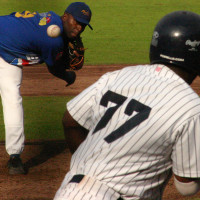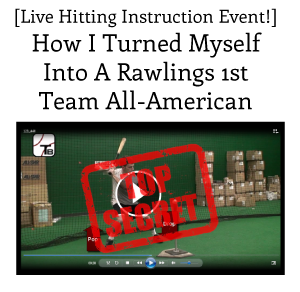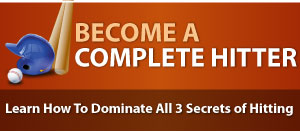
How To Crush The Curveball
Posted on 13. Aug, 2010 by bricf13 in Fundamentals, Hitting Mechanics, Tools, Youth Ball
 Crushing the Curveball
Crushing the Curveball
This week I want to discuss exactly what pitchers are trying to do with the breaking ball when they are attacking hitters. I believe that if you as a hitter understand how the pitcher is trying to go after you with the breaking ball, you will be better prepared to hit it OR lay off of it.
First lets deal with a RHP vs a RHH or LHP vs LHH
Generally speaking, early in the count the pitcher is trying to throw the curve for a strike. In doing so they are usually going to start by throwing the curve at you, usually at your waist and let it break over the plate. The idea being, if they start it at you they can raise doubt in your mind and get you to bail out or at least freeze. This pitch is actually a good one to hit because it is intended to be thrown for a strike which means it is going to cross the plate around mid-thigh level. This is an elevated curve that you can get good wood on. (as long as you don’t bail out)
Once the pitcher has two strikes on you he does not want to throw you a strike. He wants to throw a breaking ball that starts as a strike then breaks out of the zone. See the final pitch of the world series for a perfect example. By starting this breaking ball in the zone, the pitcher gets the hitter to start his bat, by breaking it out of the zone he gets the hitter to chase a bad pitch, which he is either going to miss or hit weakly. This breaking ball usually starts down the middle and breaks low and away out of the zone, often in the dirt. If as a hitter you know this, you can train yourself to take this pitch and force the pitcher to bring the ball up in the zone. Anytime you get the pitcher to bring the ball up in the zone it is going to work in your favor.
Next lets talk about the RHP vs. LHH or LHP vs. RHH
In these match-ups the breaking ball is no longer going away from the hitter but actually coming towards the hitter. Because of this, the pitcher has to adjust how he attacks the hitter with the curve. In these match-ups, the pitcher usually will try to throw a backdoor curve for a strike early in the count. Meaning he will throw the breaking ball by starting it off the outside corner of the plate then break it over the outside corner for a called strike. The thought being he will get the hitter to give up or quit on the pitch because he thinks it is a ball, and then drop it in late for an easy called strike. As long as you don’t give up on this pitch too soon, it is a good pitch to hit because it it elevated and easily shot into the opposite field.
 With two strikes, the pitcher will try to break the curve at your back big toe. He will start the breaking ball middle-in at strike height, but get it to break low and in under your bat. Usually the hitter will either swing over the top of it, foul it off his foot or dribble it weakly on the ground. Again as a hitter you must train yourself to lay off of this pitch and make the pitcher bring the ball up in the zone. If you get the pitcher bringing the ball up in zone you will have a great chance of getting a good pitch to hit.
With two strikes, the pitcher will try to break the curve at your back big toe. He will start the breaking ball middle-in at strike height, but get it to break low and in under your bat. Usually the hitter will either swing over the top of it, foul it off his foot or dribble it weakly on the ground. Again as a hitter you must train yourself to lay off of this pitch and make the pitcher bring the ball up in the zone. If you get the pitcher bringing the ball up in zone you will have a great chance of getting a good pitch to hit.
Quote of the week
The pitcher has got only a ball. I’ve got a bat. So the percentage of weapons is in my favor and I let the fellow with the ball do the fretting.
— Hank Aaron
Matt Schilling is the Senior Director of On-Field Instruction at Baseball Factory. Schilling graduated from Coastal Carolina University, where he was an All-Conference and All-State player while being voted the fourth best second baseman in the country by the Smith Award Group. Schilling went on to coach at Coastal for five years, helping them reach the top 25. He is also a former Associate Scout with the Atlanta Braves.
In my senior year of college, I finally learned what the best pro hitters do when they get to 2 strikes, and how guys like Albert Pujols hit for power, but barely strikeout. What I learned was they really change their approach at the plate in 3 key ways. I figured these secrets out and created my own 2 Strike Secrets video training program.
I cover everything I did in 2008 that drastically cut down my k’s at the plate, and ended up raising my batting average 50 points! Which probably was one of the biggest reasons I was voted to the All-American team that year.
Bottom line is this…if you’re not changing your approach with 2 strikes…if you’re still swinging the same way, and still thinking the same way you do with no strikes…you’re hurting your chances a ton.
Watch guys like Pujols and you’ll see what I’m talking about.




Trackbacks/Pingbacks
[…] This post was mentioned on Twitter by Oh.toru, Brian Moran. Brian Moran said: How To Hit The Curveball + Hitting w/ 2 Strike http://fb.me/CFyTg8JV […]